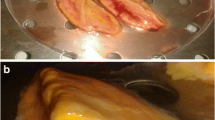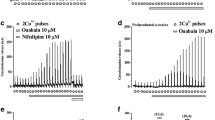Abstract
In cultured bovine adrenal chromaffln cells, charybdotoxin and iberiotoxin (inhibitors of the large-conductance Ca2+-activated K+ channel) as well as apamin (an inhibitor of the small-conductance Ca2+-activated K+ channel), at 1–100 nM, suppressed carbachol-induced 86Rb+ efflux, augmented carbachol-induced 45Ca2+ influx via voltage-dependent Ca2+ channels and catecholamine secretion and had no effect on carbachol-induced 22Na+ influx via nicotinic receptors, a prerequisite for Ca2+ channel activation by carbachol. 45Ca2+ influx caused by high K+ (a direct activation of voltage-dependent Ca2+ channels) was also enhanced by these K+ channel inhibitors, with the concentration-response curves being similar to those for carbachol-induced 45Ca2+ influx. Dendrotoxin and mast cell degranulating peptide (inhibitors of voltage-dependent K+ channels), on the other hand, did not alter carbachol-induced 86Rb+ efflux or 45Ca2+ influx.
These results suggest that the stimulation of nicotinic receptors eventually opens large- and small-conductance Ca2+-activated K+ channels, and that the blockade of these Ca2+-activated K+ channels results in gating of voltage-dependent Ca2+ channels and thereby augments catecholamine secretion from bovine adrenal chromaffln cells.
Similar content being viewed by others
References
Artalejo AR, García AG, Neher E (1993) Small-conductance Ca2+-activated K+ channels in bovine chromaffin cells. Pflügers Arch 423:97–103
Bidard J-N, Mourre C, Lazdunski M (1987) Two potent central convulsant peptides, a bee venom toxin, the MCD peptide, and a snake venom toxin, dendrotoxin I, known to block K+ channels, have interacting receptor sites. Biochem Biophys Res Commun 143:383–389
Blatz AL, Magleby KL (1987) Calcium-activated potassium channels. Trends Neurosci 10:463–467
Bräu ME, Dreyer F, Jonas P, Repp H, Vogel W (1990) A K+ channel in Xenopus nerve fibers selectively blocked by bee and snake toxins: binding and voltage-clamp experiments. J Physiol (Lond) 420:365–385
Butler A, Tsunoda S, Mccobb DP, Wei A, Salkoff L (1993) mSlo, a complex mouse gene encoding “maxi” calcium-activated potassium channels. Science 261:221–224
Castle NA, Haylett DG, Jenkinson DH (1989) Toxins in the characterization of potassium channels. Trends Neurosci 12:59–65
Dolly JO (1988) Potassium channels-what can the protein chemistry contribute? Trends Neurosci 11:186–188
Dreyer F (1990) Peptide toxins and potassium channels. Rev Physiol Biochem Pharmacol 115:93–136
Ehrengruber MU, Deranleau DA, Kempf C, Zahler P, Lanzrein M (1993) Arachidonic acid and other unsaturated fatty acids alter membrane potential in PC12 and bovine adrenal chromaffin cells. J Neurochem 60:282–288
Galvez A, Gimenez-Gallego G, Reuben JP, Roy-Contancin L, Feigenbaum P, Kaczorowski GJ, Garcia ML (1990) Purification and characterization of a unique, potent, peptidyl probe for the high conductance calcium-activated potassium channel from venom of the scorpion Buthus tamulus. J Biol Chem 265:11083–11090
Garcia ML, Galvez A, Garcia-Calvo M, King VF, Vazquez J, Kaczorowski GJ (1991) Use of toxins to study potassium channels. J Bioenerg Biomembr 23:615–646
García-Guzmán M, Sala F, Criado M, Sala S (1994) A delayed rectifier potassium channel cloned from bovine adrenal medulla, functional analysis after expression in Xenopus oocytes and in a neuroblastoma cell line. FEBS Lett 354:173–176
Hermann A, Erxleben C (1987) Charybdotoxin selectively blocks small Ca-activated K channels in Aplysia neurons. J Gen Physiol 90:27–47
Hughes M, Romey G, Duval D, Vincent JP, Lazdunski M (1982) Apamin as a selective blocker of the calcium-dependent potassium channel in neuroblastoma cells: voltage-clamp and biochemical characterization of the toxin receptor. Proc Natl Acad Sci USA 79:1308–1312
Jan LY, Jan YN (1990) How might the diversity of potassium channels be generated? Trends Neurosci 13:415–419
Marty A (1981) Ca-dependent K channels with large unitary conductance in chromaffin cell membranes. Nature 291:497–500
Marty A, Neher E (1985) Potassium channels in cultured bovine adrenal chromaffin cells. J Physiol (Lond) 367:117–141
Masuda Y, Yoshizumi M, Ishimura Y, Katoh I, Oka M (1994) Effects of the potassium channel openers cromakalim and pinacidil on catecholamine secretion and calcium mobilization in cultured bovine adrenal chromaffin cells. Biochem Pharmacol 47:1751–1758
Miller C (1991) Annus mirabilis of potassium channels. Science 252:1092–1096
Moczydlowski E, Lucchesi K, Ravindrain A (1988) An emerging pharmacology of peptide toxins targeted against potassium channels. J Membr Biol 105:95–111
Pennefather P, Lancaster B, Adams PR, Nicoll RA (1985) Two distinct Ca-dependent K currents in bullfrog sympathetic ganglion cells. Proc Natl Acad Sci USA 82:3040–3044
Pongs O (1992) Structural basis of voltage-gated K+ channel pharmacology. Trends Pharmacol Sci 13:359–365
Reinhart PH, Chung S, Lavitan IB (1989) A family of calcium-dependent potassium channels from rat brain. Neuron 2:1031–1041
Romey G, Lazdunski M (1984) The coexistence in rat muscle cells of two distinct classes of Ca2+-dependent K+ channels with different pharmacological properties and different physiological functions. Biochem Biophys Res Commun 118:669–674
Rudy B (1988) Diversity and ubiquity of K channels. Neuroscience 25:729–749
Stansfeld CE, Marsh SJ, Parcej DN, Dolly JO, Brown DA (1987) Mast cell degranulating peptide and dendrotoxin selectively inhibit a fast-activating potassium current and bind to common neuronal proteins. Neuroscience 23:893–902
Storm JF (1987) Action potential repolarization and a fast after-hyperpolarization in rat hippocampal pyramidal cells. J Physiol (Lond) 385:733–759
Takano M, Noma A (1993) The ATP-sensitive K+ channel. Prog Neurobiol 41:21–30
Twitchell WA, Rane SG (1993) Opioid peptide modulation of Ca2+-dependent K+ and voltage-activated Ca2+ currents in bovine adrenal chromaffin cells. Neuron 10:701–709
Uceda G, Artalejo AR, López MG, Abad F, Neher E, Garcia AG (1992) Ca2+-activated K+ channels modulate muscarinic secretion in cat chromaffin cells. J Physiol (Lond) 454:213–230
Uceda G, Artalejo AR, De La Fuente M-T, Lopez MG, Albillos A, Michelena P, Garcia AG, Montiel C (1994) Modulation by L-type Ca2+ channels and Apamin-sensitive K+ channels of muscarinic responses in cat chromaffin cells. Am J Physiol 266:C1432-C1439
Vázquez J, Feigenbaum P, King VF, Kaczorowski GJ, Garcia ML (1990) Characterization of high affinity binding sites for charybdotoxin in synaptic plasma membranes from rat brain. J Biol Chem 265:15564–15571
Wada A, Takara H, Izumi F, Kobayashi H, Yanagihara N (1985) Influx of 22Na through acetylcholine receptor-associated Na channels: relationship between u22Na influx, Ca influx and secretion of catecholamines in cultured bovine adrenal medullary cells. Neuroscience 15:283–292
Wada A, Takara H, Yanagihara N, Kobayashi H, Izumi F (1986) Inhibition of Na+-pump enhances carbachol-induced influx of 45Ca2+ and secretion of catecholamines by elevation of cellular accumulation of 22Na in cultured bovine adrenal medullary cells. Naunyn-Schmiedeberg's Arch Pharmacol 332:351–356
Wada A, Kobayashi H, Arita M, Yanagihara N, Izumi F (1987) Potassium channels in cultured bovine adrenal medullary cells: effects of high K, veratridine and carbachol on 86rubidium efflux. Neuroscience 22:1085–1092
Yamamoto R, Wada A, Asada Y, Yuhi T, Yanagita T, Sumiyoshi A (1994) Functional relationship between nitric oxide and noradrenaline for the modulation of vascular tone in rat mesenteric vasculature. Naunyn-Schmiedeberg's Arch Pharmacol 349:362–366
Author information
Authors and Affiliations
Rights and permissions
About this article
Cite this article
Wada, A., Urabe, M., Yuhi, T. et al. Large- and small-conductance Ca2+-activated K+ channels: their role in the nicotinic receptor-mediated catecholamine secretion in bovine adrenal medulla. Naunyn-Schmiedeberg's Arch Pharmacol 352, 545–549 (1995). https://doi.org/10.1007/BF00169389
Received:
Accepted:
Issue Date:
DOI: https://doi.org/10.1007/BF00169389




